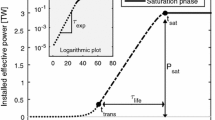Abstract
Energy for electricity and transportation is a national issue with worldwide environmental and political implications. The world must have energy options for the next century that are not vulnerable to possible disruption for technical, environmental, public confidence, or other reasons. Growing concerns about the greenhouse effect and the safety of transporting oil may lead to reduced burning of coal and other fossil fuels, and the incidents at Three Mile Island and Chernobyl, as well as nuclear waste storage problems, have eroded public acceptance of nuclear fission. Meeting future world energy needs will require improvements in energy efficiency and conservation. However, the world will soon need new central station power plants and increasing amounts of fuel for the transportation sector. The use of fossil fuels, and possibly even fission power, will very likely be restricted because of environmental, safety, and, eventually, supply considerations. Time is running out for policymakers. New energy technologies cannot be brought to the marketplace overnight. Decades are required to bring a new energy production technology from conception to full market penetration. With the added urgency to mitigate deleterious environmental effects of energy use, policymakers must act decisively now to establish and support vigorous energy technology development programs. The U.S. has invested $8 billion over the past 40 years in fusion research and development. If the U.S. fusion program proceeds according to its present strategy, an additional 40 years, and more money, will be expended before fusion will provide commercial electricity. Such an extended schedule is neither cost-effective nor technically necessary. It is time to launch a national venture to construct and operate a fusion power pilot plant. Such a plant could be operational within 15 years of a national commitment to proceed.
Similar content being viewed by others
References
National Research Council (1989). Pacing the U.S. magnetic fusion program. Final report of the Committee on Magnetic Fusion in Energy Policy (National Academy Press, Washington, D.C.), p. 8.
Starpower: The U.S. and the International Quest for Fusion Energy (1987). Office of Technology Assessment. (U.S. Congress, OTA-E-338, Oct.).
K. R. Schultz, R. F. Bourque, E. T. Cheng, B. A. Engholm, M. J. Schaffer, and C. P. C. Wong (1986). The fusion applications study—FAME,Fusion Technol.,10, 1279; General Atomics report (GA-A18658, Feb. 1988).
S. O. Dean (1988). Commercial objectives, technology transfer, and systems analysis for fusion power development.J Fusion Energy,7, 25.
J. P. Holdren, D. H. Berwald, R. J. Budnitz, J. G. Crocker, J. G. Delene, R. D. Endicott, M. S. Kazimi, R. A. Krakowski, B. G. Logan, and K. R. Schultz, (1988). Exploring the competitive potential of magnetic fusion energy: The integration of economics with safety and environmental characteristics.Fusion Technol.,3.
G. L. Kulcinski, G. A. Emmert, J. P. Blanchard, L. El-Guebaly, H. Y. Khater, J. F. Santarius, M. E. Sawan, I. N. Sviatoslavsky, L. J. Wittenberg, and R. J. Witt (1988). Apollo—An advanced fuel fusion power reactor for the 21st century, (University of Wisconsin Fusion Technology Institute Report, UWFDM-780).
J. Sheffield, R. A. Dory, S. M. Cohn, J. G. Delene, L. R. Parsly, D. E. T. F. Ashby, and W. T. Reierson (1986). Cost assessment of a generic magnetic fusion reactor.Fusion Technol.,9.
G. R. Hopkins, E. T. Cheng, R. L. Creedon, I. Maya, K. R. Schultz, P. Trestor, and C. P. C. Wong (1985). Low activation fusion design studies.Nucl. Technol./Fusion,4, 1251.
A. E. Dabiri (1986). Material options for a commercial fusion reactor first wall (ORNL/FEDC-85/9).
D. L. Smith, C. C. Baker,et al. (1984). Blanket comparison and selection study (BCSS) — Final report (Argonne National Laboratory Report, ANL/FPP-84-1).
R. W. Conn, E. E. Bloom, J. W. Davis, R. E. Gold, R. Little, K. R. Schultz, D. L. Smith, and F. W. Wiffen (1985). Report of the DOE panel on low activation materials for fusion applications (UCLA-PPG-728, University of California, Los Angeles). 1985.
D. R. Cohn and L. Bromberg (1986). Advantages of high-field tokamaks for fusion reactor development.J. Fusion Energy,5(3), 161.
J. Schwartz, L. Bromberg, D. R. Cohn, and J. E. C. Williams (1988). A commercial tokamak reactor using high-field superconducting magnets (MIT Plasma Fusion Center Report, PFC/CP-88-3, Nov. 18),Fusion Technol.,15, 957.
R. L. Miller, R. A. Krakowski, C. G. Bathke, C. Copenhaver, N. M. Schnarr, A. G. Englehardt, T. J. Seed, R. M. Zubrin (1986). Advanced tokamak reactors based on the spherical torus (ATR/ST) (LA-10740-MS, Los Alamos National Laboratory, June).
Y-K. Martin Peng (1989). “TnTau comparisons of tokamak reactors of different aspect ratios (Fusion Engineering Design Center, Oak Ridge National Laboratory; to be published).
E. Ehst, C. C. Bakeret al. (1987). A second-stability power reactor (Argonne National Laboratory Report, ANL/FPP-86-1, March).
F. Najmabadi, R. W. Conn, N. M. Ghoniem, S. P. Grotz, J. Blanchardet al. (1988). The TITAN reversed-field pinch fusion reactor study: The final report (UCLA-PPG-1200, January).
W. J. Hogan and G. L. Kulcinski (1988). Advances in ICF power reactor design.Fusion Technol.,8, 717.
E. E. Kintner (1958). Admiral Rickover's gamble.The Atlantic Monthly.
STARFIRE: A Commercial Tokamak Fusion Power Study (1980) (ANL/FPP-80-1, Argonne National Laboratory.
G. A. Moseset al., Libra-A light ion beam fusion reactor conceptual design. Proceedings of the 7th International Conference on High-Power Particle Beams (FPA-88-33, July).
B. Badgeret al. (1984). HIBALL-II — An improved conceptual heavy ion beam driven fusion reactor study (FPA-84-4).
Technical Planning Activity Final Report (1987) (Argonne National Laboratory, ANL/FPP-87-1, Jan.).
Report on Fusion Program Planning for the Early-to-mid-1990's (1988). Presented to the Magnetic Fusioni Advisory Committee by the MFAC Summer Study Panel, Sept. 1.
S. O. Dean (1988). The coming age of fusion power.Leaders Magazine,11, 150.
Magnetic Fusion Energy Engineering Act of 1980 (U.S. Congress).
Fusion Power by Magnetic Confinement: Program Plan (1976). U.S. Energy Research and Development Administration, ERDA-76/110, July).
M. Abdouet al. (1988). Modeling, analysis and experiments for fusion nuclear technology (FINESSE).Fusion Engineering and Design,6, 3.
S. L. Kahalas (1988). Future directions in inertial fusion research.J. Fusion Energy,7, 203.
Author information
Authors and Affiliations
Additional information
Prepared Under Contract for the Agency for Advancement of Fusion Power, Inc., George S. Clemens, President.




